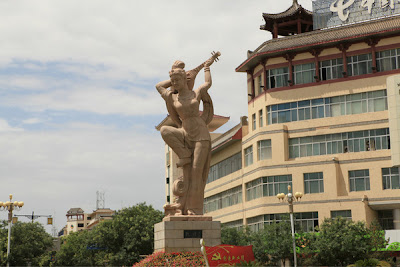Arriving at Tiananmen Square located in the center of
China's capital, I behold the majesty of the massive building that once housed
emperors, their concubines and thousands of eunuchs who were at their beck and
call. Now, swarmed with international tourists who visit the capital Beijing
throughout the year, the Forbidden City was in the past sealed off to the
commoners. Only special permission from the emperor guaranteed access to and
from this huge architecture. I gaze at the yellowish gold lion-like guardians
and the yellow glazed roof as well as bricks and realize that in my bright
yellow T-shirt, I could easily blend in with my environment. On the other hand,
yellow was thought to be the royal color and worn only by Chinese emperors. So
if I lived back then, I guess the imperial guards would have dragged me off to
be beheaded!
The Forbidden City is a literal translation from Zijing
Cheng in Chinese, which means purple forbidden city. However, I cannot make
out any physical features that are in purple. Did the ravages of time remove
them? The ancient Chinese astrologers believed that Polaris, called Ziwei
or the Purple Star, was the center of heaven. The heavenly emperor lived in a
purple palace and similarly the emperor on earth should live in a purple city
or purple palace.
I admire its beauty and am astounded by the ancient
Chinese who were so intelligent and skilful to have built this Forbidden City
in just a period of 14 years from 1406 to 1420. In my mind's eye, I can almost
see the millions of workers who slogged and slaved everyday to make this
miraculous structure possible. Their blood, sweat and tears accomplished this
feat without any modern tools or technology.
The entire rectangular complex comprise 980 buildings and
span 7,800,000 square feet (720, 000 m2). At the end of the Yuan
Dynasty when China was under Mongol control, Emperor Zhu Di or Yong Le, the
second emperor of the succeeding dynasty, the Ming Dynasty, moved the capital
back from Nanjing to Beijing. This was after his father, Emperor Hong Wu, the
founder of the Ming Dynasty, burnt down the Mongol palaces in central Beijing
and moved the capital from Beijing to Nanjing. I mean talk about being
rebellious against your parents. This Yong Le was definitely a rebel at heart.
There are 980 buildings with some 8,886 rooms, not
including other internal chambers. Surrounding the Forbidden City is a moat
measuring 171 feett
(52 m) wide and walls at some 32 feet (10 m) high. The City is also gated on
its four sides, starting with the main gate at the southern end, the Meridian
Gate, followed by the Gate of the Divine Might at the northern end. The other
two gates are named East Glorious Gate and the West Glorious Gate. Another
tourist that has already seen the East Glorious Gate and tells me that it is
the only door that has eight rows of nine golden doornails each, while the
other three have nine rows.
From the Meridian Gate, I walk along that central gateway
that is part of the Imperial Way. This gateway formed part of the ancient city
of Beijing and only the Emperor was allowed to walk or ride on this path. I
felt quite honored strolling on the same path. Besides the monarch, only the
Empress on her wedding day and students from the Imperial Examination could
ever step on this pathway.
In addition, this massive complex is divided into two,
the Outer Court and the Inner Court. The ceremonial events were held in the
Outer Court while the Emperor and his extended household resided in the Inner
Court. No wonder, UNESCO listed it as a World Heritage Site in 1987.
Today, it comes under the purview of the Palace Museum,
which was established in 1924. The Palace Museum currently holds a vast
collection numbering nearly one million, of mostly from the Qing Dynasty, which
consists of ceramics, bronze ware, timepieces, jade and imperial artifacts.
Part of the collection can also be found in the National Palace Museum in
Taipei, Taiwan.
With China opening its gates to international visitors
and investors, how has the Forbidden City withstood the influx of Western
culture? A Starbucks coffee chain outlet that opened in 2000 was closed seven
years later due to local protests. Coffee? Come on people, the Chinese simply
love drinking tea too much!
The City was also the site of the oscar-winning movie, Last
Emperor by Bernardo Bertolucci. This epic film commissioned by the Chinese
government used Forbidden City as the setting for the story of Puyi, the last
emperor of the Qing Dynasty.
This impressive complex has been the home to 14 Ming
Dynasty emperors and ten Manchurian emperors of China's last dynasty. What
secrets do the walls of the Forbidden City hold? The secrets will probably
remain hidden.
























